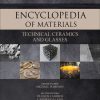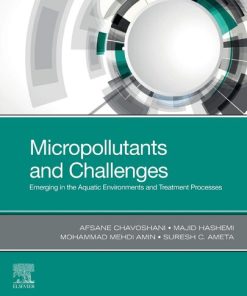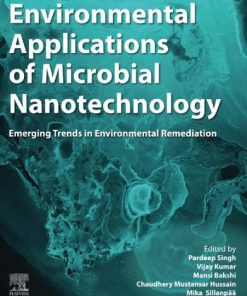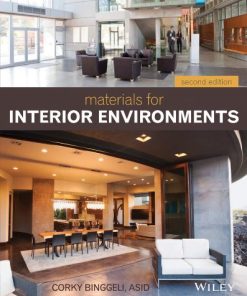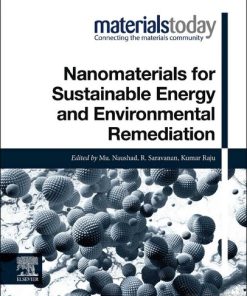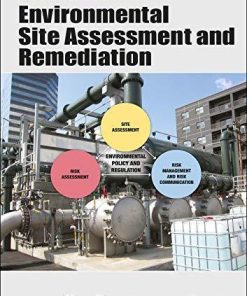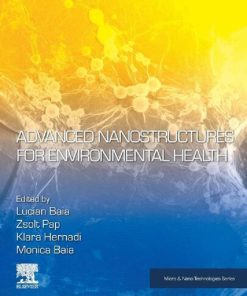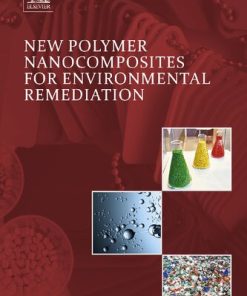Advanced Materials for Sustainable Environmental Remediation Terrestrial and Aquatic Environments 1st edition by Dimitrios Giannakoudakis 0323904866 9780323904865
$50.00 Original price was: $50.00.$25.00Current price is: $25.00.
Advanced Materials for Sustainable Environmental Remediation: Terrestrial and Aquatic Environments 1st edition by Dimitrios A. Giannakoudakis – Ebook PDF Instant Download/DeliveryISBN: 0323904866 9780323904865
Full download Advanced Materials for Sustainable Environmental Remediation: Terrestrial and Aquatic Environments 1st edition after payment.
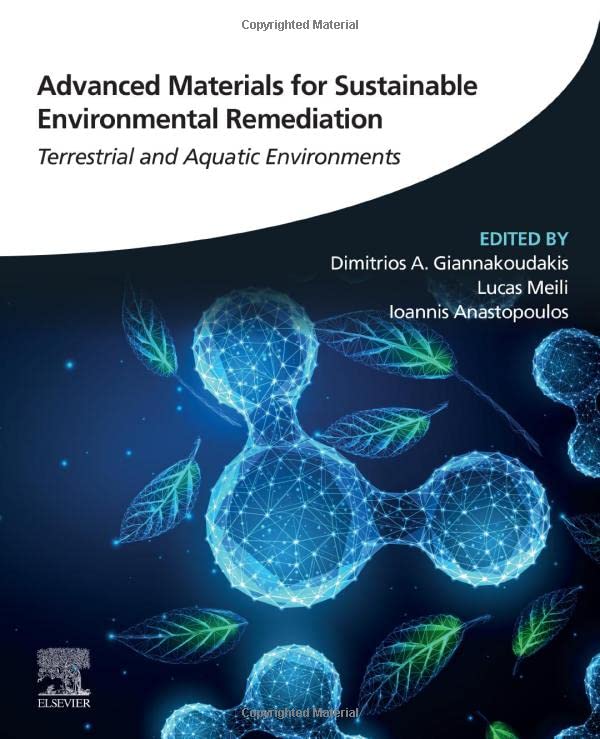
Product details:
ISBN-10 : 0323904866
ISBN-13 : 9780323904865
Author : Dimitrios A. Giannakoudakis
Advanced Materials for Sustainable Environmental Remediation: Terrestrial and Aquatic Environments presents detailed, comprehensive coverage of novel and advanced materials that can be applied to address the growing global concern of the pollution of natural resources in waters, the air and soil. It provides fundamental knowledge on available materials and treatment processes, as well as applications, including adsorptive remediation and catalytic remediation. Organized clearly by type of material, this book presents a consistent structure for each chapter, including characteristics of the materials, basic and important physicochemical features for environmental remediation applications, routes of synthesis, recent advances as remediation medias, and future perspectives.
Advanced Materials for Sustainable Environmental Remediation: Terrestrial and Aquatic Environments 1st Table of contents:
Chapter 1 Trends in advanced materials for sustainable environmental remediation
1.1 Environmental pollution and role of materials in its remediation
1.2 Strategies for environmental remediation
1.3 Present challenges and future prospects for utilization of advanced materials in sustainable environmental remediation
Conclusion
References
Chapter 2 Potential of MOF-based novel adsorbents for the removal of aquatic pollutants
2.1 Introduction
2.2 Various forms of aquatic pollutants
2.3 Traditional approaches for the treatment of aquatic pollutants
2.4 Overview of MOFs
2.5 Applications of MOFs for the treatment of aquatic pollutants
2.6 Large-scale production of the MOFs
2.7 Challenges and future directives
Conclusions
References
Chapter 3 Metal-organic frameworks for the prolific purification of hazardous airborne pollutants
3.1 Introduction
3.2 Structural features of MOFs
3.3 Synthesis of MOFs
3.4 Adsorptive purification of airborne pollutants
3.5 Innovative strategies for performance enhancement
3.6 Comparison with commercial adsorbents
3.7 Regeneration and reusability
3.8 Prospects and challenges
3.9 Conclusion
References
Chapter 4 Advanced materials for sustainable environmental remediation: Terrestrial and aquatic environments; MOF-based materials as soil amendments
4.1 Introduction
4.2 Classification and toxicity of soil pollutants
4.3 Overview of available methods to identify/remove soil pollutants
4.4 Prerequisite structural advantages of MOFs and their composites for the remediation and quantification of soil contaminants
4.5 MOFs as an efficient tool for soil remediation
4.6 Confronts and future scope of this technology
Conclusions
Abbreviations
References
Chapter 5 Metal-organic frameworks (MOFs) as a catalyst for advanced oxidation processes—Micropollutant removal
5.1 Introduction
5.2 Methods of synthesis
5.3 MOFs and their derivatives
5.4 Applications of MOFs in AOP
5.5 Strategies to improve performance of MOFs
5.6 Stability and reusability
Conclusion
References
Chapter 6 Engineering structured metal-organic frameworks for environmental applications
6.1 Introduction
6.2 Spheres
6.3 Pellets
6.4 Monoliths
6.5 3D-printed monoliths
Conclusions and further outlook
References
Chapter 7 Aerogel, xerogel, and cryogel: Synthesis, surface chemistry, and properties—Practical environmental applications and the future developments
7.1 Introduction
7.2 Preparation and affecting synthesis parameters of aerogels, cryogels, and xerogels
7.3 Features and applications of aerogels, cryogels, and xerogels
7.4 Surface chemistry of aerogels, cryogels, and xerogels
7.5 Environmental applications of aerogels, cryogels, and xerogels
Conclusion and future development
References
Chapter 8 Nanoscale cellulose and nanocellulose-based aerogels
8.1 Introduction
8.2 Cellulose and nanocellulose
8.3 Nanocellulose-based aerogels
8.4 Applications of nanoscale cellulose
8.5 Perspective and outlook
8.6 Summary
References
Chapter 9 Sol-gel–derived silica xerogels: Synthesis, properties, and their applicability for removal of hazardous pollutants
9.1 Introduction and overview of sol-gel method
9.2 Engineering the porosity and surface chemistry of silica xerogels
9.3 Adsorptive removal of hazardous pollutants
9.4 Summary and outlook
References
Chapter 10 Processing of hybrid TiO2 semiconducting materials and their environmental application
10.1 Introduction
10.2 Methods for the processing of hybrid TiO2
10.3 Processing of hybrid TiO2 nanomaterials
10.4 Environmental application of hybrid TiO2 nanoparticles
Conclusions and perspectives
References
Chapter 11 Fundamentals of layered double hydroxides and environmental applications
11.1 Introduction
11.2 Layered double hydroxides
11.3 Environmental applications
Conclusion and Future Perspectives
References
Chapter 12 Green nanocomposites and gamma radiation as a novel treatment for dye removal in wastewater
12.1 Introduction
12.2 Textile dyes and wastewater
12.3 Green synthesis of iron oxide nanoparticle and water remediation
12.4 Iron oxide nanoparticles supported on ion‐exchange resins
12.5 Water remediation using gamma irradiation
12.6 Water remediation by using iron oxides nanoparticles-based composites
Conclusions
Acknowledgments
Abbreviations
References
Chapter 13 Potential of zeolite as an adsorbent for the removal of trace metal(loids) in wastewater
13.1 Trace metal(loids) contamination in water
13.2 Zeolite: Chemistry
13.3 Role of zeolite in remediation of trace metal(loids) contaminants
13.4 Modification of zeolite for the removal of toxic metals
13.5 Summary and future perspectives
References
Chapter 14 Natural and synthetic clay-based materials applied for the removal of emerging pollutants from aqueous medium
14.1 Introduction
14.2 Natural clays for adsorption
14.3 Modified and synthesized clay-based materials for adsorption
14.4 Adsorption of emerging contaminants by natural and modified clays
14.5 Comparison of different activation methods in the same clay type
14.6 Future perspectives and final remarks
Acknowledgments
References
Chapter 15 Application of magnetic biochars for the removal of aquatic pollutants
15.1 Introduction
15.2 Fabrication techniques for magnetic biochar
15.3 Physicochemical properties of magnetic biochar
15.4 Factors affecting the adsorption of pollutants
15.5 Applications of magnetic biochar
15.6 Adsorption mechanisms
15.7 Magnetic biochar regeneration and disposal
Conclusions and future recommendations
Acknowledgments
References
Chapter 16 Progress in the synthesis and applications of polymeric nanomaterials derived from waste lignocellulosic biomass
16.1 Overview on the lignocellulosic-derived nanomaterials
16.2 Isolation of lignocellulosic-based nanomaterials
16.3 Functionality improvement through structural modification of nanocellulose obtained from biomass
16.4 Progress in the application of cellulose and lignin-derived nanoparticles
16.5 Conclusions
References
Chapter 17 Activated carbons in full-scale advanced wastewater treatment
17.1 Activated carbons
17.2 Environmental challenges driving the use of activated carbon in urban wastewater treatment
17.3 Activated carbon based processes for controlling CECs in wastewater treatment
17.4 Activated carbons used for wastewater treatment
17.5 Final remarks and research needs
Acknowledgments
Acronyms and abbreviations
References
Chapter 18 Carbon nanotube-based materials for environmental remediation processes
18.1 Introduction
18.2 Overview of CNTs synthesis and characterization techniques
18.3 CNTs as adsorbents, membranes, and photocatalysts
18.4 CNT combined with biopolymers
18.5 Environmental and human safety
18.6 CNT-based biomaterials in environmental remediation
Conclusions and remarks
References
Chapter 19 Applications of graphene oxide (GO) and its hybrid with nanoparticles for water decontamination
19.1 Introduction
19.2 Graphene oxide (GO) and reduced graphene oxide (rGO): Chemical and structural properties, synthetic routes of obtention, and use in anchoring and stabilization
19.3 Organic and inorganic pollutants: Application of GO and hybrid GO nanomaterials to removal contaminants
19.4 Utilization of GO and hybrid-GO nanomaterials to water disinfection contaminated with viruses and bacteria
19.5 Conclusions
Acknowledgments
References
Chapter 20 Graphitic carbon nitride: Triggering the solar light–assisted decomposition of hazardous substances
20.1 Introduction
20.2 Synthesis of materials and their characteristics
20.3 Photoactivity mechanisms of diverse g-C3N4
20.4 The extent of decomposition of hazardous substances
20.5 Conclusion
List of abbreviations
References
Chapter 21 Utilization of fly ash-based advanced materials in adsorptive removal of pollutants from aqueous media
21.1 Introduction
21.2 Synthesis methods of fly ash- / modified fly ash-based adsorbents
21.3 Application of fly ash-based materials for adsorption of pollutants from water
21.4 Future perspectives
Acknowledgments
References
Chapter 22 Activated carbons derived from biomass for the removal by adsorption of several pesticides from water
22.1 Introduction
22.2 Modeling sustainable activated carbons for the removal of pesticides by adsorption
22.3 Kinetic modeling
22.4 Isotherm modeling
22.5 Thermodynamic studies
22.6 Relation between adsorption capacity and surface area in the adsorption process of several pesticides by biomass-derived carbon materials
22.7 Concluding remarks and recommendations for future work
Acknowledgments
References
Chapter 23 Synthesis and application of nanostructured iron oxides heterogeneous catalysts for environmental applications
23.1 Introduction
23.2 Pristine and engineered iron oxides: Synthesis routes
23.3 Properties of nanostructured iron oxides
23.4 Application of nanostructured iron oxides for environmental remediation
People also search for Advanced Materials for Sustainable Environmental Remediation: Terrestrial and Aquatic Environments 1st:
what is environmental remediation
environmental remediation examples
types of environmental remediation
advanced sustainable engineered solutions llc
advancing sustainable materials management
Tags:
Advanced Materials,Sustainable Environmental,Remediation,Terrestrial,Aquatic Environments,Dimitrios Giannakoudakis
You may also like…
Engineering
Engineering
Advanced remote sensing terrestrial information extraction and applications Second Edition Liang
Engineering - Environmental
Chemistry - Biochemistry


